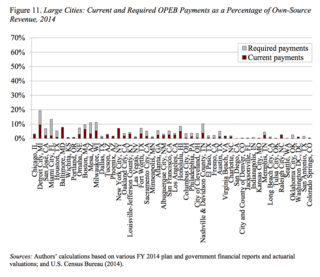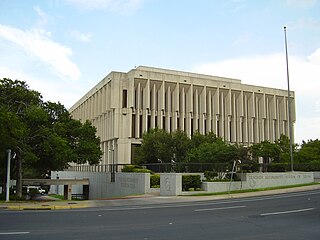Related Research Articles

A pension is a fund into which amounts are paid regularly during an individual's working career, and from which periodic payments are made to support the person's retirement from work. A pension may be:
A pension fund, also known as a superannuation fund in some countries, is any program, fund, or scheme which provides retirement income.

The Employee Retirement Income Security Act of 1974 (ERISA) is a U.S. federal tax and labor law that establishes minimum standards for pension plans in private industry. It contains rules on the federal income tax effects of transactions associated with employee benefit plans. ERISA was enacted to protect the interests of employee benefit plan participants and their beneficiaries by:

The U.S. Railroad Retirement Board (RRB) is an independent agency in the executive branch of the United States government created in 1935 to administer a social insurance program providing retirement benefits to the country's railroad workers.

The California Public Employees' Retirement System (CalPERS) is an agency in the California executive branch that "manages pension and health benefits for more than 1.5 million California public employees, retirees, and their families". In fiscal year 2020–21, CalPERS paid over $27.4 billion in retirement benefits, and over $9.74 billion in health benefits.

The Pension Benefit Guaranty Corporation (PBGC) is a United States federally chartered corporation created by the Employee Retirement Income Security Act of 1974 (ERISA) to encourage the continuation and maintenance of voluntary private defined benefit pension plans, provide timely and uninterrupted payment of pension benefits, and keep pension insurance premiums at the lowest level necessary to carry out its operations. Subject to other statutory limitations, PBGC's single-employer insurance program pays pension benefits up to the maximum guaranteed benefit set by law to participants who retire at 65. The benefits payable to insured retirees who start their benefits at ages other than 65 or elect survivor coverage are adjusted to be equivalent in value. The maximum monthly guarantee for the multiemployer program is far lower and more complicated.
The pensions crisis or pensions timebomb is the predicted difficulty in paying for corporate or government employment retirement pensions in various countries, due to a difference between pension obligations and the resources set aside to fund them. The basic difficulty of the pension problem is that institutions must be sustained over far longer than the political planning horizon. Shifting demographics are causing a lower ratio of workers per retiree; contributing factors include retirees living longer, and lower birth rates. An international comparison of pension institution by countries is important to solve the pension crisis problem. There is significant debate regarding the magnitude and importance of the problem, as well as the solutions. One aspect and challenge of the "Pension timebomb" is that several countries' governments have a constitutional obligation to provide public services to its citizens, but the funding of these programs, such as healthcare are at a lack of funding, especially after the 2008 recession and the strain caused on the dependency ratio by an ageing population and a shrinking workforce, which increases costs of elderly care.

Pensions in the United States consist of the Social Security system, public employees retirement systems, as well as various private pension plans offered by employers, insurance companies, and unions.

Other postemployment benefits is a term used in the United States to describe the benefits that an employee begins to receive at the start of their retirement. These benefits do not include the pension paid to the retired employee. "Other postemployment benefits" were originally intended to be an important source of supplemental coverage for people on Medicare. Typically this means that if employees retire before the age of 65 they can remain on their employer's health plan. Upon turning 65 they leave their employers plan for Medicare but still receive additional benefits from their employer. These benefits may include health insurance and dental, vision, prescription, or other healthcare benefits provided to eligible retirees and their beneficiaries. They also may include life insurance, disability insurance, long-term care insurance, and other benefits.

The Pension Protection Act of 2006, 120 Stat. 780, was signed into law by U.S. President George W. Bush on August 17, 2006.
The Illinois Municipal Retirement Fund is the second largest and best-funded public pension system in Illinois. Since 1941, has partnered with local units of government to provide retirement, disability and death benefits for public employees. With a funded status of about 98 percent and more than $50 billion in assets, IMRF is well-funded and sustainable.
India has a robust social security legislative framework governing social security, encompassing multiple labour laws and regulations. These laws govern various aspects of social security, particularly focusing on the welfare of the workforce. The primary objective of these measures is to foster sound industrial relations, cultivate a high-quality work environment, ensure legislative compliance, and mitigate risks such as accidents and health concerns. Moreover, social security initiatives aim to safeguard against social risks such as retirement, maternity, healthcare and unemployment while tax-funded social assistance aims to reduce inequalities and poverty. The Directive Principles of State Policy, enshrined in Part IV of the Indian Constitution reflects that India is a welfare state. Food security to all Indians are guaranteed under the National Food Security Act, 2013 where the government provides highly subsidised food grains or a food security allowance to economically vulnerable people. The system has since been universalised with the passing of The Code on Social Security, 2020. These cover most of the Indian population with social protection in various situations in their lives.

Teacher Retirement System of Texas (TRS) is a public pension plan of the State of Texas. Established in 1937, TRS provides retirement and related benefits for those employed by the public schools, colleges, and universities supported by the State of Texas and manages a $180 billion trust fund established to finance member benefits. More than 1.6 million public education and higher education employees and retirees participate in the system. TRS is the largest public retirement system in Texas in both membership and assets and the sixth largest public pension fund in America. The agency is headquartered at 1000 Red River Street in the capital city of Austin.
The Indiana State Teachers’ Retirement Fund (TRF) was created by the Indiana General Assembly in 1921. Today, TRF manages and distributes the retirement benefits of educators in all public schools, as well as some charter schools and universities, throughout Indiana. Headed by a governor-appointed executive director and a six-member Board of Trustees, TRF aims to prudently manage the fund in accordance with fiduciary standards, provide quality benefits, and deliver a high level of service to TRF members while demonstrating responsibility to the citizens of the state.

Defined benefit (DB) pension plan is a type of pension plan in which an employer/sponsor promises a specified pension payment, lump-sum, or combination thereof on retirement that depends on an employee's earnings history, tenure of service and age, rather than depending directly on individual investment returns. Traditionally, many governmental and public entities, as well as a large number of corporations, provide defined benefit plans, sometimes as a means of compensating workers in lieu of increased pay.
In France, pensions fall into five major divisions;
Oklahoma Teacher's Retirement System (OTRS) is the pension program for public education employees in the State of Oklahoma. As of June 30, 2014, the program had nearly 168,000 members. Public education teachers and administrators are required to be OTRS members; support staff can join voluntarily. State law established OTRS in 1943 to manage retirement funds and provide financial security for public education employees. Its first checks to retirees were sent out in 1947. It is administered by a staff and 14-member board of trustees. Its current executive director is Tom Spencer, who started in that position on November 1, 2014.

The city of Detroit, Michigan, filed for Chapter 9 bankruptcy on July 18, 2013. It is the largest municipal bankruptcy filing in U.S. history by debt, estimated at $18–20 billion, exceeding Jefferson County, Alabama's $4-billion filing in 2011. Detroit is also the largest city by population in U.S. history to file for Chapter 9 bankruptcy, more than twice as large as Stockton, California, which filed in 2012. While Detroit's population had declined from a peak of 1.8 million in 1950, its July 2013 population was reported by The New York Times as a city of 700,000.
The Los Angeles County Employees Retirement Association (LACERA) is an independent Los Angeles County agency that administers and manages the retirement fund for the County and outside Districts. In 2012, it managed defined benefit pension plans for 156,563 civil servants (members), including 56,752 retirees, making it the largest county retirement system in the United States. In 2018, LACERA's net assets were worth US$55.8billion.
The Illinois pension crisis refers to the rising gap between the pension benefits owed to eligible state employees and the amount of funding set aside by the state to make these future pension payments. As of 2020, the size of Illinois' pension obligation is $237B, but the state's pension funds have only $96B available for payouts to retirees.
References
- ↑ "About ORS". Michigan Office of Retirement Services. Michigan.gov. Retrieved 30 August 2013.
- ↑ "Pensionomics 2016 - Michigan" (PDF). National Institute on Retirement Security. Retrieved March 20, 2018.
- ↑ "The Trillion Dollar Gap: Underfunded state retirement systems and the roads to reform" (PDF). The Pew Center on the States. Retrieved 24 September 2013.
- ↑ "State and Local Pension Costs: Pre-Crisis, Post-Crisis and Post-Reform" (PDF). Center for Retirement Research at Boston College. Retrieved 23 September 2013. paragraph not supported by source
- ↑ "2,000 state workers to shuffle offices in region". Lansing State Journal. Retrieved 8 July 2015.
- ↑ Michigan Public Act 240 of 1943 (PDF). Michigan Legislature. 1943.
- ↑ Michigan Public Act 150 of 1967. Michigan Legislature. 1967.
- ↑ Michigan Public Act 300 of 1980 (PDF). Michigan Legislature. 1980.
- ↑ Michigan Public Act 182 of 1986 (PDF). Michigan Legislature. 1986.
- ↑ Michigan Public Act 234 of 1992 (PDF). Michigan Legislature. 1992.
- ↑ Comprehensive Annual Financial Report for the Fiscal Year Ended September 30, 2017 - Michigan State Employees' Retirement System (PDF). Financial Services for Office of Retirement Services. 2017.
- ↑ "MI-SERA Website". Michigan State Employee Retiree Association. Retrieved 24 September 2013.
- ↑ "It's Retirement Time". Michigan Dept. of Military and Veterans Affairs. Retrieved 24 September 2013.
- ↑ "ORS Military". Michigan.gov. Retrieved 30 August 2013.
- ↑ Comprehensive Annual Financial Report for the Fiscal Year Ended September 30, 2017 - Michigan Public School Employees' Retirement System (PDF). Financial Services for Office of Retirement Services. 2017.
- ↑ "Michigan Public School Employees Retirement System". Blue Cross Blue Shield Blue Care Network. Retrieved 24 September 2013.
- ↑ "Michigan Education Association Website". Michigan Education Association. Retrieved 24 September 2013.
- ↑ Comprehensive Annual Financial Report for the Fiscal Year Ended September 30, 2017 - Michigan State Police Retirement System (PDF). Financial Services for Office of Retirement Services. 2017.
- ↑ Comprehensive Annual Financial Report for the Fiscal Year Ended September 30, 2017 - Michigan Judges' Retirement System (PDF). Financial Services for Office of Retirement Services. 2017.